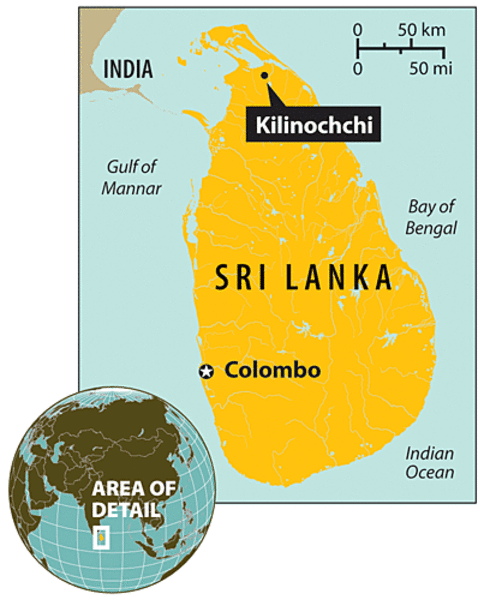Sri Lanka advances on rebel base
Loading...
| Colombo, Sri Lanka
After 25 years of fighting and 70,000 casualties, Sri Lanka's military has won a hard-fought upper hand against separatist Tamil Tigers – and now vows to break their northern stronghold by year's end.
Yet despite these gains, government claims that the end to one of South Asia's longest-running civil wars is near may be premature: Even if the Tigers' conventional fighting forces fall apart, the group can prolong the conflict by turning to guerrilla tactics and feeding off ethnic Tamils' discontent against the government. Meanwhile the military's intensified campaign has caused the humanitarian crisis to swell.
"As an organization that started as a small guerilla group, the [Tigers] will retain [their] capacity to go back to their origins," says Jehan Perera, director of the National Peace Council of Sri Lanka, an independent advocacy organization. "The havoc that even a small group of determined persons can do is inestimable."
Nearing the Tiger stronghold
The separatist group, called the Liberation Tigers of Tamil Eelam (LTTE), has repeatedly defied heavy odds and predictions of imminent defeat since they formed in the 1970s to fight for an independent Tamil homeland in Sri Lanka's north and east. But even government critics agree that the latest military offensive has tremendous momentum.
In January, the government abandoned a Norway-brokered cease-fire and said it would defeat the Tigers by the end of the year. It has since poured $1.5 billion into an all-out offensive that has killed about 6,000 rebels and shrunk their territory in the island's northern Wanni region by nearly 75 percent, according to the Ministry of Defense. Restrictions on journalists make independent verification impossible.
Although exaggerations are common in the propaganda war between the sides, a string of important battlefield victories have propelled the military forward. The military says some advance units are now within artillery range of Kilinochchi, where Tiger chief Velupillai Prabhakaran is thought to be hiding in a heavily defended underground bunker complex. Fierce clashes are expected there, as hundreds of the Tigers' elite cadres are believed to have dug in for a siege.
Of the factors that have weakened the LTTE, none has been more instrumental than the 2004 decision of the former second-in-command, Col. Karuna Amman, to split. He has said he left the Tigers due to Mr. Prabhakaran's repeated failure to pursue a political solution at critical moments; and his preference for northern Tamils over eastern Tamils, whom he says did most of the fighting. He took 6,000 cadres with him, cutting the Tigers' fighting strength by 60 percent. Last July, the LTTE was ousted from the east.
The group's finances are also feeling the squeeze. A 2007 report by Jane's Intelligence Review said that at their peak the LTTE raised as much as $300 million a year – 90 percent from abroad – making it the second-highest budget among separatist groups. Members of the Tamil diaspora community are often intimidated into giving a large portion of their earnings to the cause, according to Human Rights Watch.
But in recent years a worldwide dragnet on fundraising operations and weapons procurement has cramped the Tigers, which are listed as a terrorist organization by the United States. The group has been called the "most dangerous and deadly extremists in the world" by the FBI. Dozens of LTTE financiers and arms smugglers have been arrested by authorities in the US, Canada, Europe, and India; millions in assets have been seized or frozen.
Separatists could turn to guerrilla tactics
Still, the current offensive may have yet to encounter the full weight of the LTTE – or its long-term ability to feed conflict. One Colombo-based analyst, speaking on condition of anonymity, points out that Prabhakaran is a master tactician who still commands hundreds of ultra-loyal fighters protecting him and possibly even chemical weapons. In the past, the Tigers have given up territory to draw government forces in and then counterattacked, he adds.
Even if LTTE is soon broken as a conventional fighting force, it could regroup in remote jungle areas to wage a protracted guerrilla war. This would include greater reliance on suicide and hit-and-run attacks to "bomb themselves back onto the agenda" as they have done in the past, says Paikiasothy Saravanamuttu, director of the Center for Policy Alternatives, a think tank in Colombo.
Despite the military's recent gains, he adds, unrest will not cease until the economic and political deprivations that fuel Tamil discontent are addressed by the government, which has favored the Sinhalese majority. Even Sri Lankan Army commander Gen. Sarath Fonseka has warned that conflict could sputter along for another two decades unless a political resolution is reached.
More than 100,000 people displaced
Meanwhile, the stepped-up fighting has deepened a humanitarian crisis inside rebel-held territory. The United Nations says that in the past two months more than 112,000 ethnic Tamils have been displaced, bringing the total number of refugees to 145,000. Aid agencies in the north are trying to provide some relief to those displaced, but supplies are running low and access limited due to shifting front lines. So far clashes along the southern edge of the war zone have made some exit points off-limits, trapping people inside, the military has confirmed.
Human rights group Amnesty International says the LTTE is forcibly recruiting women and children to fill depleted ranks, as well as moving families toward the capital to serve as a human shield. Pro-LTTE media reports counter that people are freely enlisting by the hundreds.
• This article was reported with a grant from the Pulitzer Center on Crisis Reporting.





